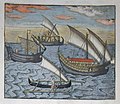Fichier:Four Kind of Ships which Bantenese Use de Bry.jpg

Taille de cet aperçu : 691 × 600 pixels. Autres résolutions : 277 × 240 pixels | 553 × 480 pixels | 885 × 768 pixels | 1 180 × 1 024 pixels | 1 282 × 1 113 pixels.
Fichier d’origine (1 282 × 1 113 pixels, taille du fichier : 694 kio, type MIME : image/jpeg)
Historique du fichier
Cliquer sur une date et heure pour voir le fichier tel qu'il était à ce moment-là.
| Date et heure | Vignette | Dimensions | Utilisateur | Commentaire | |
|---|---|---|---|---|---|
| actuel | 28 mars 2020 à 16:02 |  | 1 282 × 1 113 (694 kio) | Verosaurus | Changes resolution |
| 28 mars 2020 à 11:46 |  | 701 × 607 (260 kio) | Verosaurus | {{Information |description ={{en|1=De Bry, Johann Theodor, (1560-1623) and Johann Israel de Bry (1565-1609). Part III, Plate 28, Shown are Four Kinds of Ships Which the Bantenese Use. From the "Little Voyages"<br><br>ASIAN VESSELS IN BANTAM<br>The illustration shows four different types of vessel in the harbor of the trading town of Bantam on the northwestern tip of Java. The vessel on the left, with the high running aft and the two yards is called a iuncos in the journal, which is also ca... |
Utilisation du fichier
La page suivante utilise ce fichier :
Usage global du fichier
Les autres wikis suivants utilisent ce fichier :
- Utilisation sur en.wikipedia.org
- Utilisation sur id.wikipedia.org
- Utilisation sur ms.wikipedia.org
- Utilisation sur uk.wikipedia.org